
Ribbon-cutting officially opens the Semans-Griswold Environmental Hall at Washington College on Sept.18, 2019. L-R Peter Franchot, Md. Comptroller; Kurt Landgraf, Washington College president; Truman Semans; Jay Griswold; Larry Culp, WC Board; John Seidel. WC professor of anthropology — Photo by Peter Heck
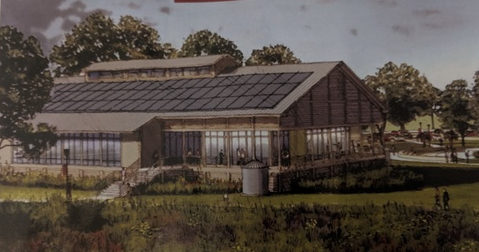
Architect’s rendering of Washington College’s new Semans-Griswold Environmental Hall on the Chester River. Note the 300-solar panel array on the rooftop.
Washington College opened the new Semans-Griswold Environmental Hall Friday, Oct. 18 with a ceremonial ribbon-cutting and a public tour of the new riverside facility. The weather was beautiful.
With guests including Maryland Comptroller Peter Franchot, the ceremonies drew a standing-room only crowd to a large tent on the lawn between the college’s new boathouse and the building being dedicated.
College President Kurt Landgraf greeted the audience, calling the occasion “a historic moment for Washington College.” He welcomed Franchot and thanked the state of Maryland for its support for the project. The state provided $4 million toward the new center. He also recognized Lawrence Culp, former chairman of the college’s Board of Visitors and Governors, for his leadership in the fundraising campaign for the building. As chair of the fundraising committee for the new center, Culp helped to raise $11.5 million in just six months.
“With great optimism and foresight, College leaders identified the perfect spot for the center’s waterfront home, right here—a former brownfields site where a fertilizer plant and a fuel depot once stood,” Landgraf said. “The College’s decision to rehabilitate this land and to design a low-impact building that would rely solely on renewable energy sources speaks volumes about the institutional commitment to environmental conservation and the values of responsible citizenship we hope to impart to our students.”
Franchot then took the podium. He gave commemorative medals to Culp, Prof. John Seidel, director of the Center for Environment and Society, and to Truman Semans and Jay Griswold, the two men for whom the new building is named. The medals continue a tradition begun by former Comptroller Louis Goldstein, a graduate and strong supporter of Washington College. Noting the educational purpose of the new building, Franchot said he looks forward to a new generation of leaders who advocate for the environment.
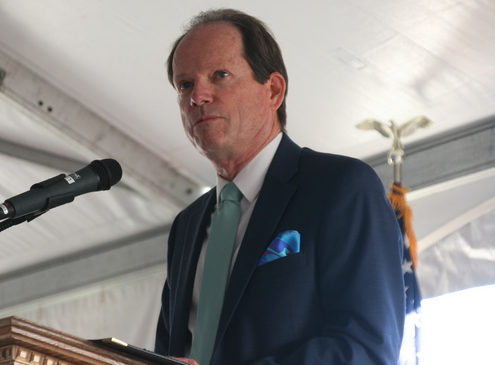
John Seidel, WC anthropology professor and director of the Center for Environment and Society. — Photo by Jane Jewell
Seidel gave a brief history of the project, saying he and Bryan Matthews had proposed a waterfront campus 11 years ago. While the project took time to complete, the final stage of actually building it took less than a year. He said the environmental center would be “a game-changer” for recruiting new students, adding a new dimension to the college’s already strong assets of its location on the Eastern Shore and the Chester River. With this new building, Seidel said, Washington College is on the threshold of becoming “the best small college in the country” in terms of its environmental studies program. He noted the building’s “truly sustainable” design as a clear statement of the college’s commitment to the health of the environment.
The college chose a design that meets the Living Buildings Challenges standard, with a focus on connecting the people who occupy it with the natural environment. The layout, with large windows giving a spectacular view of the river and adjacent wetlands, makes the most of natural lighting. And with 300 solar panels on the roof, the building is expected to generate 105% of its annual energy needs, saving the college some $19,000 annually on electrical bills. This is especially impressive given the high energy demands of science laboratories, Seidel said. He looked to the future of the environmental program, saying that the new building would create “a critical mass here on the water” to give the college an even more powerful commitment to protecting the natural setting.
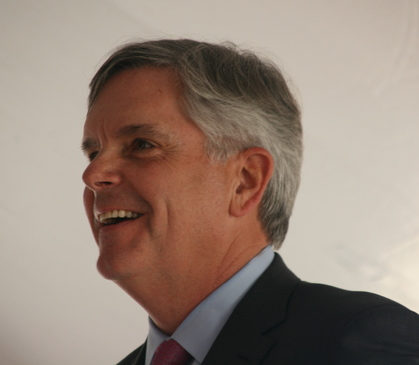
Larry Culp, former chair of Washington College’s Board of Visitors and Governors,
Culp took the podium to note the long list of those who contributed to the project, noting that neither Semans nor Griswold had wanted their names on the building. “Sorry!” he said, to laughter from the audience. But, he noted, the two men had made long-term commitments to the college and its mission, making it “so fitting” to name the building for them.
Landgraf then recognized the two men with special awards. He presented Griswold with a Lifetime Achievement Award in Conservation, recognizing his role in the Chesapeake Bay Foundation and the Living Classrooms program. Griswold was on the WC board for years and then served as the interim president of Washington College during the 2014-2015 school year while the board searched for a new president for the college. Griswold, Landgraf said, has been “an outspoken critic of misguided proposals” such as the plan to build an industrial-scale wind farm in Kent County. Griswold responded with a warm narrative of how he was recruited to the college’s board by Semans, Goldstein, and others. Being on the college’s board, he said, has been a wonderful and “eye-opening experience.” He concluded by repeating Goldstein’s signature line, “God bless you all real good.”
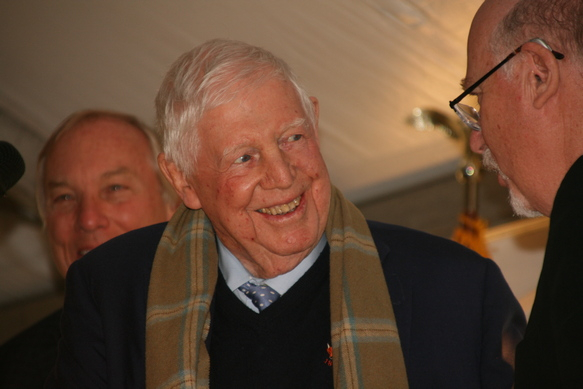
Truman Semans (center) receiving an honorary doctorate from WC President Kurt Landgraf with Comptroller Franchot behind. — Photo by Jane Jewell
Semans was awarded an honorary Doctorate of Public Service, the college’s highest honor. Landgraf noted Semans’ role in founding the Chesapeake Bay Foundation, making him a “living figure of environmental stewardship.” Semans said he was humbled to receive the degree. He thanked some of those who helped him along the way, including Griswold and his brother, Culp, Clinton Daly, and Dr. Harry Sears. He said he would strive to live up to the honor, and wished the college continued success.
A ribbon-cutting concluded the formal ceremonies, after which the public was invited to visit the building and partake of light refreshments. Once inside, it becomes clear what a masterpiece of modern “green” engineering and artistic design the new Semans-Griswold Environmental Hall is. There are classrooms, offices, labs, and conference rooms in a very inviting and open 11,500 square foot floorplan. Several entire walls of windows provide marvelous views of the river and wetlands. More than one visitor was overheard to say that they’d have trouble getting any work done due to being distracted by the wonderful views! This is a great step forward for the college’s expanding biology and environmental programs.

Washington College President Kurt Landgraf at the dedication of the new Semans-Griswold Environmental Hall, 18 October 2019 — Photo by Jane Jewell
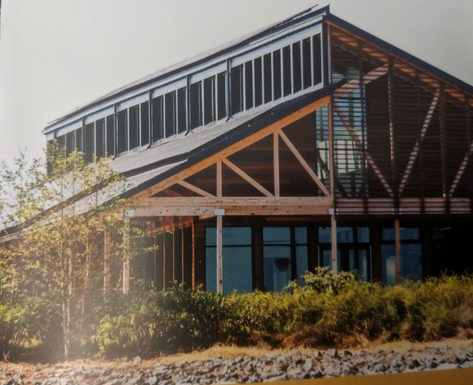
Washington College’s new Semans-Griswold Environmental Hall on the Chester River.
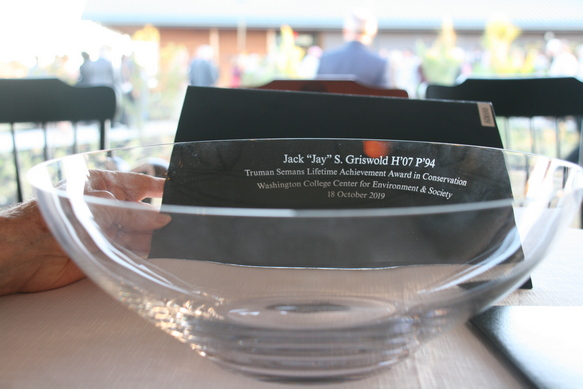
Engraved bowl presented to Jack “Jay” Griswold as the first recipient of the Truman Semans Lifetime Achievement in Conservation. — Photo by Jane Jewell with some handy assistance from professor emeritus of chemistry Frank Creegan
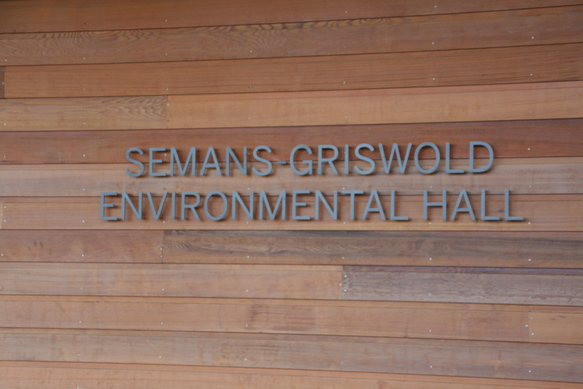
Semans-Griswold Environmental Hall sign near the main entrance — Photo by Jane Jewell



Write a Letter to the Editor on this Article
We encourage readers to offer their point of view on this article by submitting the following form. Editing is sometimes necessary and is done at the discretion of the editorial staff.